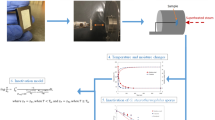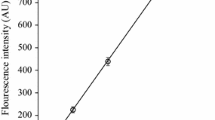Abstract
Biological indicators are important tools in infection control via sterilization process monitoring. The use of a standardized spore crop with a well-defined heat resistance will guarantee the quality of a biological indicator. Ambient factors during sporulation can affect spore characteristics and properties, including heat resistance. The aim of this study is to evaluate the main sporulation factors responsible for heat resistance in Geobacillus stearothermophilus, a useful biological indicator for steam sterilization. A sequence of a three-step optimization of variables (initial pH, nutrient concentration, tryptone, peptone, beef extract, yeast extract, manganese sulfate, magnesium sulfate, calcium chloride and potassium phosphate) was carried out to screen those that have a significant influence on heat resistance of produced spores. The variable exerting greatest influence on G. stearothermophilus heat resistance during sporulation was found to be the initial pH. Lower nutrient concentration and alkaline pH around 8.5 tended to enhance decimal reduction time at 121 °C (D121°C). A central composite design enabled a fourfold enhancement in heat resistance, and the model obtained accurately describes positive pH and negative manganese sulfate concentration influence on spore heat resistance.



Similar content being viewed by others
References
Amaha M, Ordal JZ (1957) Effect of divalent cations in the sporulation medium on the thermal death rate of Bacillus coagulans var. thermoacidurans. J Bacteriol 74:596–604
Beaman TC, Gerhardt P (1986) Heat resistance of bacterial spores correlated with protoplast dehydration, mineralization and thermal adaptation. Appl Environ Microbiol 52:1242–1246
Bender GR, Marquis RE (1985) Spore heat resistance and specific mineralization. Appl Environ Microbiol 50:1414–1421
Bovallius A, Zacharias B (1971) Variations in the metal content of some commercial media and their effect on microbial growth. Appl Microbiol 22:260–262
Cazemier AE, Wagenaars SFM, Steeg PF (2001) Effect of sporulation and recovery medium on the heat resistance and amount of injury of spores from spoilage bacilli. J Appl Microbiol 90:761–777
Charney J, Fisher WP, Hegarty CP (1951) Manganese as an essential element for sporulation in the genus Bacillus. J Bacteriol 62:145–148
Cheung HY, Vitkovic L, Brown MRW (1982) Toxic effect of manganese on growth and sporulation of Bacillus stearothermophilus. J Gen Microbiol 128:2345–2402
Craven SE (1990) The effect of the pH of the sporulation environment on the heat resistance of Clostridium perfingens spores. Curr Microbiol 22:233–237
FDA—Food and Drug Administration (2007) Guidance for industry and FDA staff—biological indicator (BI) Intended to monitor sterilizers used in heath care facilities: remarket Notification [510(k)] Submissions
Feeherry FE, Munsey DT, Rowley ADB (1987) Thermal inactivation and injury of Bacillus stearothermophilus spores. Appl Environ Microbiol 53:365–370
Ghosh S, Ramirez-Peralta A, Gaidamakova E, Zhang P, Li YQ, Daly MJ, Setlow P (2011) Effects of Mn levels on resistance of Bacillus megaterium spores to heat, radiation and hydrogen peroxide. J Appl Microbiol 111:663–670
Gould GW, Dring GJ (1975) Heat resistance of bacterial endospores and concept of an expanded osmoregulatory cortex. Nat 258:402–405
Granger AC, Gaidamakova EK, Matrosova VY, Daly MJ, Setlow P (2011) Effects of Mn and Fe levels on Bacillus subtilis spore resistance and effects of Mn2+, other divalent cations, orthophosphate, and dipicolinic acid on protein resistance to ionizing radiation. Appl Environ Microbiol 77:32–40
Grant CL, Pramer D (1962) Minor element composition of yeast extract. J Bacteriol 84:869–870
Hoxey EV, Soper CJ, Davies DJ (1985) Biological indicators for low temperature steam formaldehyde sterilization: effect of defined media on sporulation, germination index and moist heat resistance at 110 degrees C of Bacillus strains. J Appl Bacteriol 58:207–214
International Standard ISO 11138-3 (2006) Sterilization of health care products—Biological indicators Part 3: biological indicators for moist heat sterilization processes, 2nd edition
Kihm DJ, Hutton MT, Hanlin JH, Johnson EA (1990) Influence of transition metals added during sporulation on heat resistance of Clostridium botulinum 113B Spores. Appl Environ Microbiol 56:681–685
Latimer JM, Matsen JM (1977) Microwave oven irradiation as a method for bacterial decontamination in a clinical microbiology laboratory. J Clin Microbiol 6:340–342
Marquis RE, Bender GR (1985) Mineralization and heat resistance of bacterial spores. J Bacteriol 161:789–791
Marquis RE, Sim J, Shin SY (1994) Molecular mechanisms of resistance to heat and oxidative damage. J Appl Bacteriol Symp Suppl 76:40–48
Mazas M, López M, González I, Bernardo A, Martín R (1997) Effects of sporulation pH on the heat resistance and the sporulation of Bacillus cereus. Lett Appl Microbiol 25:331–334
Melly E, Genest PC, Gilmore ME, Little S, Popham DL (2002) Analysis of the properties of spores of Bacillus subtilis prepared at different temperatures. J Appl Microbiol 92:1105–1115
Minh HN, Durand A, Loison P, Perrier-Cornet JM, Gervais P (2011) Effect of sporulation conditions on the resistance of Bacillus subtilis spores to heat and high pressure. Appl Microbiol Biotechnol 90:1409–1417
Palop A, Sala FJ, Condon S (1999) Heat resistance of native and demineralized spores of Bacillus subtilis sporulated at different temperatures. Appl Environ Microbiol 65:1316–1319
Penna TCV, Machoshvili IA, Taqueda MES, Ishii M (2000) The effect of media composition on the thermal resistance of Bacillus stearothermophilus. PDA J Pharm Sci Technol 54:398–412
Penna TCV, Machoshvili IA, Ishii M (2003) Effect of media on spore yield and thermal resistance of Bacillus stearothermophilus. Appl Biochem Biotechnol 106:287–294
Rowe JJ, Goldberg ID, Amelunten RE (1975) Development of defined and minimal media for the growth of Bacillus stearothermophilus. J Bacteriol 124:279–284
Setlow P (2006) Spores of Bacillus subtilis: their resistance to radiation, heat and chemicals. J Appl Microbiol 101:514–525
Smith GM, Kopelman M, Jones A, Pflug IJ (1982) Effect of environmental conditions during heating on commercial spore strip performance. Appl Environ Microbiol 44:12–18
Unger-Bimczok B, Kottke V, Hertel C, Rauschnabel J (2008) The influence of humidity, hydrogen peroxide concentration, and condensation on the inactivation of Geobacillus stearothermophilus spores with hydrogen peroxide vapor. J Pharm Innov 3:123–133
USP—United States Pharmacopeia XXXI (2008) Biological indicators resistance and performance tests. In: The United States Pharmacopeia, 31th rev. United States Pharmacopoeia Convection, Rockville, MD
Wright AM, Hoxey EV, Soper CJ, Davies DJG (1995) Biological indicators for low temperature steam and formaldehyde sterilization: the effect of defined media on sporulation, growth index and formaldehyde resistance of spores of Bacillus stearothermophilus strains. J Appl Bacteriol 79:432–438
Yamazaki K, Kawai Y, Inoue N, Shinano H (1997) Influence of sporulation medium and divalent ions on the heat resistance of Alicyclobacillus acidoterrestris spores. Lett Appl Microbiol 25:153–156
Author information
Authors and Affiliations
Corresponding author
Additional information
Communicated by Erko Stackebrandt.
Electronic supplementary material
Below is the link to the electronic supplementary material.
Rights and permissions
About this article
Cite this article
Guizelini, B.P., Vandenberghe, L.P.S., Sella, S.R.B.R. et al. Study of the influence of sporulation conditions on heat resistance of Geobacillus stearothermophilus used in the development of biological indicators for steam sterilization. Arch Microbiol 194, 991–999 (2012). https://doi.org/10.1007/s00203-012-0832-z
Received:
Revised:
Accepted:
Published:
Issue Date:
DOI: https://doi.org/10.1007/s00203-012-0832-z




